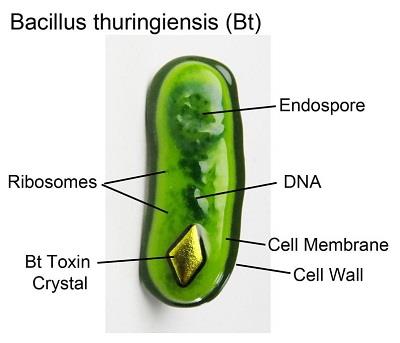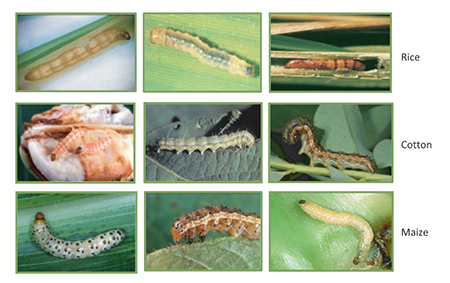Bacillus thuringiensis
- русский язык имя
- английское имяBacillus thuringiensis
- CAS №68038-71-1
- CBNumberCB7848438
- ФормулаC22H32N5O16P
- мольный вес0
- EINECS614-245-1
- номер MDLMFCD01769457
- файл MolMol file
| Температура кипения | 100°C |
| плотность | 09 mg/ml |
| цвет | Light reddish-brown suspension concentrate inwater |
| Запах | fishy odor,Nonflammable |
| Рейтинг продуктов питания EWG | 1 |
| FDA UNII | 3TK3LQP1N7 |
| Система регистрации веществ EPA | Bacillus thuringiensis (68038-71-1) |
| Банк данных об опасных веществах | 68038-71-1(Hazardous Substances Data) |
| Токсичность | LD50 oral in rat: > 20gm/kg |
рисовальное письмо(GHS)
-
рисовальное письмо(GHS)

-
сигнальный язык
опасность
-
вредная бумага
H319:При попадании в глаза вызывает выраженное раздражение.
H335:Может вызывать раздражение верхних дыхательных путей.
H317:При контакте с кожей может вызывать аллергическую реакцию.
H334:При вдыхании может вызывать аллергическую реакцию (астму или затрудненное дыхание).
-
оператор предупредительных мер
P261:Избегать вдыхания пыли/ дыма/ газа/ тумана/ паров/ аэрозолей.
P264:После работы тщательно вымыть кожу.
P272:Не уносить загрязненную спецодежду с места работы.
P280:Использовать перчатки/ средства защиты глаз/ лица.
P285:В случае недостаточной вентиляции используйте средства защиты органов дыхания.
P302+P352:ПРИ ПОПАДАНИИ НА КОЖУ: Промыть большим количеством воды.
P304+P341:В случае пожара: Риск взрыва. Покинуть опасную зону. НЕ тушить пожар в случае распространения огня на взрывчатые вещества.
P305+P351+P338:ПРИ ПОПАДАНИИ В ГЛАЗА: Осторожно промыть глаза водой в течение нескольких минут. Снять контактные линзы, если Вы ими пользуетесь и если это легко сделать. Продолжить промывание глаз.
P333+P313:При возникновении раздражения или покраснения кожи обратиться за медицинской помощью.
P342+P311:При возникновении симптомов астмы или затрудненного дыхания обратиться за медицинской помощью.
P363:Перед повторным использованием выстирать загрязненную одежду.
P501:Удалить содержимое/ контейнер на утвержденных станциях утилизации отходов.
Bacillus thuringiensis химические свойства, назначение, производство
Описание
Bacillus thuringiensis or Bt is a naturally occurring rod-shaped, spore-forming, aerobic, grampositive micro-organism (bacterium) that is found throughout most areas of the world. It can be found in soils and on leaves/needles and in other common environmental situations. When the bacteria produces spores, it also produces unique crystalline proteins. When eaten, these natural proteins are toxic to certain insects, but not to human beings, birds, or other animals.
Bacillus thuringiensis is the most widely known and researched bacterium within this group and is differentiated from other spore-forming bacilli by the presence of a parasporal body that is formed within the sporangium during sporogenesis. The parasporal body is a high-molecular-mass protein crystal that is referred to as crystalline protein, δ-endotoxin, as well as a parasporal body. This protein moiety possesses some of the insecticidal properties of the bacterium.
История
Bacillus thuringiensis (Bt) is a bacterium that was first identified by S. Ishiwata in 1901 in Japanese silkworms presenting flacherie, or flaccid disease. It was later scientifically described and named by E. Berliner in Thüringen, Germany (Knowles 1994) . Berliner noted that the bacterium was producing insecticidal crystal (Cry) proteins, which were causing cell death in the digestive tract. These proteins have been used in insecticidal sprays and dusts to control pest insects since the 1930s. However, today they are most widely utilized as a transgene inserted into crop plants. These transgenic plants (Bt crops) are able to express the bacterial toxin-genes to defend themselves against herbivory. The use of these crops has been effective in controlling pest populations and increasing crop yield and quality. Bt crops were first commercialized in 1996 and, in 2013 187.5 million acres of Bt transgenic crops were planted worldwide (James et al. 2014).Использование
Bt has been used in spray formulations for more than 40 years, and more recently its insecticidal protein genes have been incorporated into several major crops. Due to their insecticidal activity, Cry toxins are used worldwide as bioinsecticides to control disease-vector insect and crop pest populations.One of the most successful applications of Bt has been the control of lepidopteran defoliators, which are pests of coniferous forests mainly in Canada and the United States. Bt subsp. israelensis (Bti) is highly active against larvae of disease-vector mosquitoes like Aedes aegypti (vector of dengue fever), Aedes albopictus (vector of chikungunya), Simulium damnosum (vector of onchocerciasis), and certain Anopheles species (vectors of malaria). Bti formulations (WG, water-dispersible granule; DT, ready-to-use tablet) have been evaluated by the World Health Organization Pesticide Evaluation Scheme (WHOPES) and recommended as mosquito larvicides, including their use against mosquito larvae that develop in drinking-water containers. Successful application of Bt is highly dependent on proper timing, weather conditions, and dosage of spray applications. These factors combine to determine the probability of larvae ingesting a lethal dose.
Recently, the use of Cry toxins has increased dramatically following the introduction of cry genes into plants. These ‘Bt crops’ have thus far proved to be an effective control strategy, and in 2004 Bt-maize and Bt-cotton were grown on 22.4 million hectares worldwide. Such widespread use, however, has led to concerns about the effect Bt crops may have on the environment and on human health.
Биологические функции
These early experiments showed that Bt toxins needed to be activated in the gut, and it was soon discovered that the critical factors were an alkaline environment and the presence of specific proteases, which cleaved the innocuous protoxin into its active form. Once activated by proteolysis, each toxin binds to receptors in the brush border membrane and causes pores to open, disrupting them ovement of solutes across the gut epithelium and causing the influx of water. The toxins were shown to be orally lethal to caterpillars in pure form, and the pro-toxins could be converted into active toxinsin vitro, using specific pro-teases under alkaline conditions. The requirement for alkaline conditions, specific proteases and specific receptors explains why Bt is harmless to mammals (which have anacidic gut and lack the corresponding receptors) and why each toxin has a narrow host range. Nine common pests of rice, cotton and maize that are controlled by Bt crops
Nine common pests of rice, cotton and maize that are controlled by Bt crops
Угроза здоровью
The insecticidal action of B.t. is attributed to protein crystals produced by the bacte- rium. Exposures of test animals to B.t. using several routes did not produce any acute toxicity in birds, dogs, guinea pigs, mice, or rats. Also laboratory rats when injected with B.t.k., showed no toxic or virus-like effects. No oral toxicity was found in rats, mice, or Japanese quail fed protein crystals from B.t. var. israelensis. Studies indicated that after rats ate B.t., the microorganism remained in the digestive system until it was eliminated from the body. Rabbits exposed to B.t. showed mild skin irritation and rats showed low inhalation toxicity to B.t. In fact, chronic toxicity studies in dogs, guinea pigs, rats, and other species of test animals showed no evidence of adverse health effects. The toxicity of B.t. is insect specii c. Researches have provided valuable data and identii ed B.t. subspecies that differ in toxicity to different insects. Examples of B.t. subspecies and the insects they affect are aizawai (moths), kurstaki (moths), israelen- sis (mosquitoes and l ies), and tenebrionis (beetles). Also, phytotoxicity studies (plant researches) showed B.t. genes in some crops (B.t. crops) to combat insects of corn crops, cotton, and potatoes. B.t. must be eaten by insects to be effective and works by interfer- ing with digestion. Insects are most sensitive to B.t. when they are larvae, an immature life stage. Insects that eat B.t., die from hunger or infection. It does not cause disease outbreaks in insect populations. B.t. may produce toxic chemicals that are released from the organismСельскохозяйственное использование
Bacillus thuringiensis (Bt) is an important insect pathogenic bacterium commercially known as 'Thuricide' It releases toxic polypeptide crystals which are degradable by the enzyme, protease. The bacterium is pathogenic to the following insects: Lepidoptera, Diptera and Coleoptera.Bacillus thuringiensis has been exploited commercially and its sprays have been used in the USA since the 1930s. It is the only commercialized transgene. The Bt toxin provides resistance against insects by binding to specific sites in the insect gut. However, insect resistance to Bt is also known.
Профиль безопасности
Low toxicity by ingestion and skincontact. When heated to decomposition it emits acridsmoke and irritating vapors.Экологическая судьба
Bt Cry and Cyt toxins belong to a class of bacterial toxins known as pore-forming toxins (PFT) that are secreted as watersoluble proteins undergoing conformational changes in order to insert into, or to translocate across, cell membranes of their host. The primary action of Cry toxins is to lyse midgut epithelial cells in the target insect by forming pores in the apical microvilli membrane of the cells.Bt is ineffective against adult insects and must be eaten by feeding larvae in order to be toxic. When ingested by insect larvae, sporulated-Bt crystalline inclusions dissolve in the alkaline environment of insect gut, and the solubilized inactive protoxins are converted into protease resistant active Cry and Cyt toxins. Toxin activation involves N-terminal, Cterminal, and intra-molecular cleavage. The activated Cry toxins are composed of three functional domains, a seven ahelices bundle that is involved in membrane insertion (domain I), and two b-sheet domains (domains II and III) involved in receptor interactions. Once activated, Cry toxins bind to specific receptors on the brush border membrane of the midgut epithelium columnar cells before inserting into the membrane. Toxin insertion leads to the formation of lytic pores in microvilli of apical membranes. Subsequently cell lysis and disruption of the midgut epithelium release the cell content providing the spores with a germinating medium leading to a severe septicemia and insect death.
Bacillus thuringiensis запасные части и сырье
Bacillus thuringiensis поставщик
| поставщик | телефон | страна | номенклатура продукции | благоприятные условия |
|---|---|---|---|---|
| +8615531157085 | China | 8804 | 58 | |
| +86 13288715578 +8613288715578 |
China | 12825 | 58 | |
| +8617531153977 | China | 5855 | 58 | |
| +8617732866630 | China | 18147 | 58 | |
| +86-371-86557731 +86-13613820652 |
China | 20259 | 58 | |
| +8613343047651 | China | 3692 | 58 | |
| +86-371-66670886 | China | 19902 | 58 | |
| +86-0371-55170693 +86-19937530512 |
China | 21632 | 55 | |
| +86-0551-65418679 +8618949832763 |
China | 2986 | 55 | |
| +86-0371-86658258 +8613203830695 |
China | 29871 | 58 |
Bacillus thuringiensis Обзор)
- Алюминия ацетилацетона
- Трис (2,2,6,6-тетраметил-3 ,5-heptanedionato) диспрозий (III)
- Бензил изоцианид
- N-бутил изоцианид
- Трис (2,2,6,6-тетраметил-3 ,5-heptanedionato) европий (III)
1of3